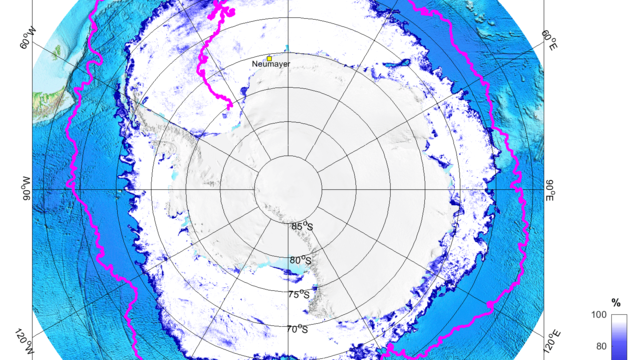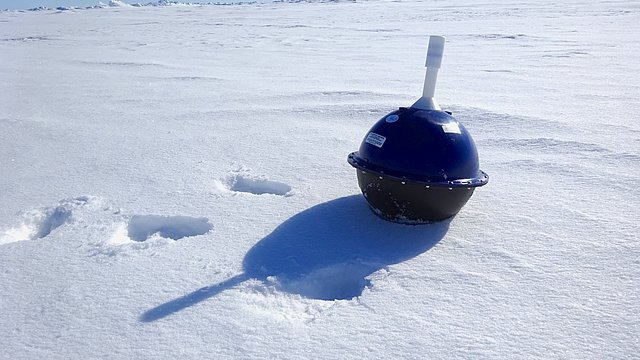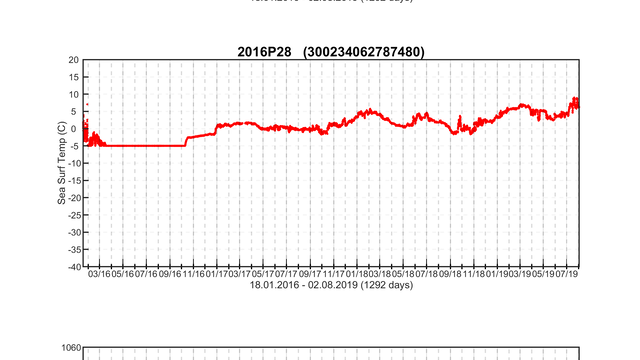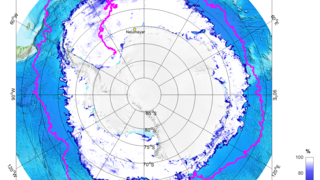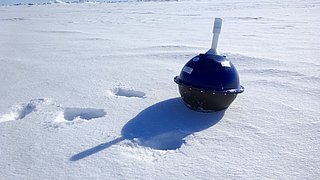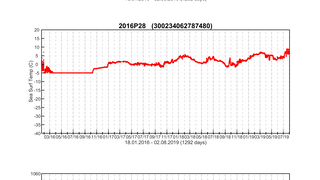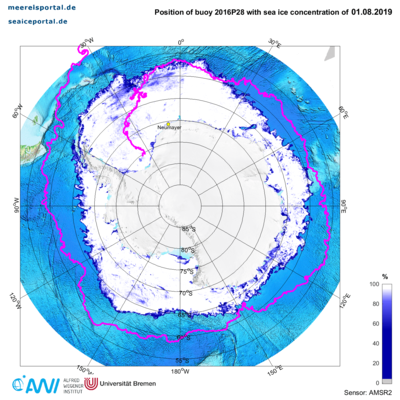The record-breaking journey began when Stefanie Arndt and Leonard Rossmann from the Alfred Wegener Institute, Helmholtz Centre for Polar and Marine Research (AWI) in Bremerhaven placed the buoy on the frozen surface of the Weddell Sea in the Antarctic. Since then 2016P28 has been in regular satellite contact, transmitting data that provides a wealth of information regarding the complex links between the ice, ocean currents, the weather and climate.
When on 18 January 2016, in the middle of the Antarctic summer, the two AWI researchers were taken by helicopter from the research icebreaker Polarstern to an ice floe in the Weddell Sea to position four measuring stations, neither of them had the history of polar research in mind. On board the expedition ship Resolution the English seafarer James Cook had written one of the first chapters in that history when, on his second Antarctic Ocean voyage, from 1772 to 1775, he became the first person to circumnavigate the Antarctic. Among the crew was the naturalist Georg Forster, the first German to set foot on the South Georgia Islands, which are part of Antarctica. Accordingly, the first German research station on the Antarctic continent, which the GDR put into operation on 21 April 1976, bore his name.
Almost 40 years later to the day, as Stefanie Arndt and Leonard Rossmann were busy setting up an automatic measuring station in the Weddell Sea to provide data on the ice and snow there, little did they know that one of the three additional instruments installed by the Australian Antarctic Division (AAD) would set off on a journey similar to the one that Cook and Forster had made more than two centuries earlier. “These stations consist of a buoy roughly 30 centimetres in diameter, which is placed on the ice, but can also float in the water,” explains Stefanie Arndt. At regular intervals, the devices report their position and other measurements, such as the temperature; a few of the buoys also measure the atmospheric pressure.
Every year, AWI researchers working with Marcel Nicolaus place several of these measuring buoys on the ice in various locations throughout the Weddell Sea. On the Polarstern research expedition from February to April 2019, for example, 17 buoys were deployed. As long as the equipment is working, the researchers can follow their route – and therefore the route of the ice floe the buoys are on. Since the ice in the Antarctic isn’t a rigid sheet, but instead is constantly changing, the three measuring buoys, which were initially set up in a triangular formation about ten to twenty kilometres apart, took very different routes.
At the end of the summer, the sun provides less and less energy to the ice-cold Antarctic waters, and the first ice layer forms, growing day by day. By the time the winter draws to a close, there are massive two-metre-thick ice sheets floating on the Antarctic Ocean. This ice is then carried by the ocean currents, but at the same time, the often-strong winds over the water can shove the ice sheets in different directions. In some places, storms stack the ice layers on top of each other, creating pack ice hummocks that can reach heights of several metres. Elsewhere, on the other hand, the ice floes are broken up and open water appears. In winter, new ice rapidly forms in these areas. When the southern summer comes and the sun once again provides more energy, within a few months this ice sheet – with a combined area roughly the size of Europe – almost completely vanishes.
With the help of data sent from the ‘drift buoys’, the researchers can now follow a small part of this process. After several years, this provides them with a picture of the currents, winds and storms that carry and push the ice – together with the automatic stations – in different directions. If the ice melts or the ice floe breaks apart, the buoy lying on top slips into the water and the sensor begins measuring the temperature of the seawater, which can be as low as minus 1.8 degrees. “This tells us that the buoy is no longer lying on the ice, but is floating in the water instead,” explains sea-ice physicist Stefanie Arndt.
At some point, the batteries are drained and the drift buoy stops transmitting. In some cases, a leak allows seawater to seep in, rapidly putting the sensitive electronics out of action. Or the equipment is damaged by any number of other processes, and the researchers lose contact with it. Sooner or later, all the buoys stop working; only very few keep transmitting for much more than a year.
However, the AAD Buoy 2016P28 has gone the distance, and is still diligently transmitting data on its record-breaking journey across the Antarctic Ocean three-and-a-half years after it was first deployed, on 18 January 2016. For the first ten months, the buoy apparently lay on the ice, which was originally 1.83 metres thick, with a 19-centimetre layer of snow cover. During this time, it drifted across the Weddell Sea on the ice. In late November 2016, the data suddenly showed temperatures of minus 1.8 to minus 1.9 degrees Celsius. The ice had obviously melted in the early Antarctic summer and the buoy was now floating in the frigid water.
The ocean currents slowly carried the station out of the Weddell Sea and the buoy was caught in the Antarctic Circumpolar Current, which transports ice-cold water from Africa and South America around the Antarctic in a clockwise direction. After a total of two years, the drift buoy had travelled nearly halfway around the ice-covered continent, and after three years it had completed almost 90 percent of the route. In doing so, it followed a similar course to the one that Cook and Forster had taken almost two centuries earlier on board the Resolution. Cook’s ship, however, made lengthy detours to New Zealand and the South Seas. In April 2019, the drift buoy floated through the Drake Passage between South America and the Antarctic Peninsula, and on 17 June 2019 it reached the same longitude as where the AWI researchers had placed it on the ice in the Weddell Sea three years and five months earlier.
In the meantime, the drift buoy has once again left the Antarctic Circumpolar Current and is slowly drifting with the currents of the South Atlantic toward warmer waters. On its long journey, the 2016P28 may not have discovered any new islands as James Cook once did, but it has certainly gathered valuable new information on the currents in the Antarctic Ocean, which have a significant influence on the weather in the Southern Hemisphere.
Contacts
- Dr. Marcel Nicolaus (AWI)
- Dr. Stefanie Arndt (AWI)
Questions?
Contact us via E-Mail or our contact form.
Graphics
